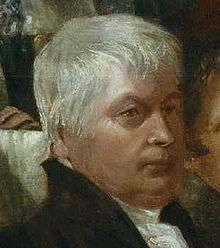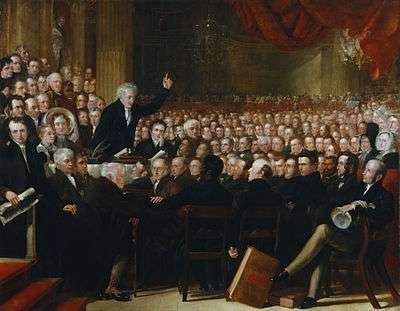Samuel Gurney (1786–1856)

Samuel Gurney (18 October 1786 – 5 June 1856) was an English banker and philanthropist from the Gurney family of Norwich. He should not be confused with his second son, Samuel (1816–1882), also described as banker and philanthropist, and a Member of Parliament.[2]
Early years and marriage
Gurney was born at Earlham Hall[3] near Norwich, England, 18 October 1786, the second son of John Gurney (1749–1809),[4] a Quaker banker of Norwich, and Catherine, the daughter of Daniel Bell (1728–1750), a London merchant from Stamford Hill. The family's Gurneys Bank was founded in 1770.
Gurney was educated at Wandsworth, Surrey, and at Hingham, Norfolk. Among his siblings were Joseph John Gurney, Daniel Gurney (1791–1880),[5] Elizabeth Fry, Louisa Hoare (1784–1836),[6] the wife of Samuel Hoare, and Hannah Buxton, the wife of Sir Thomas Buxton. At the age of fourteen, Gurney was placed in the counting-house of his brother-in-law, Joseph Fry (1777–1861),[7] a tea merchant and banker, at St Mildred's Court, Poultry, in the City of London. [8]
Overend & Gurney
The wealth that came to Gurney from his father-in-law, as well as that bequeathed to him by his father, helped him to rapid progress as a partner in Richardson & Overend, with which firm he had become connected in 1807. [8] This business had been founded in 1800 by Thomas Richardson, clerk to a London bill-discounter, and John Overend, chief clerk in the bank of Smith, Payne & Company at Nottingham, the Gurneys supplying the capital. At that time bill-discounting was carried on in a spasmodic fashion by the ordinary merchant in addition to his regular business, but Richardson considered that there was room for a London house which should devote itself entirely to the trade in bills. This, at that time, novel idea proved an instant success. On his father's death in 1809, Samuel Gurney assumed the control of the Norwich bank. At the same time, he took control of Richardson & Overend. The title of that firm was subsequently changed to Overend, Gurney and Company.[9]
Very soon after his entering the firm, it began to assume gigantic proportions, and it was for about forty years the largest discounting house in the world. At first only discounting bills, it soon came to lending money on all sorts of securities. In the panic of 1825, the firm were able to lend money to many houses to tide them over their difficulties; this brought them into even greater favour. Gurney became known as "the bankers' banker", and many firms who had previously dealt with the Bank of England now commenced depositing their surplus cash in his hands. At the time of Gurney's death in 1856, it was calculated that this house held deposits amounting to eight million pounds sterling.[8] (The bank collapsed in 1866, owing millions.)
Philanthropic interests
During the later years of his life, charitable and philanthropic undertakings almost monopolized Gurney's attention. [9]
- Penal reform and criminal justice
Gurney took a part in the efforts of Joseph John Gurney, Fowell Buxton, and Elizabeth Fry for the improvement of prison discipline and the reform of the criminal code. He refused to prosecute a man who had forged his name, knowing well that death was the punishment for such an offence.
- Anti-slavery

Gurney attended the 1840 World Anti-Slavery Convention in London and he was a prime figure in the painting which is now in the National Portrait Gallery in London.[1] He is in the foreground of the painting on the left.
The second international Anti-Slavery convention was in 1843 when Gurney was the chairman of the convention.[10] Richard Peek took the chair of the convention when Gurney had to leave.
- Africa
He also interested himself in the Niger Expedition of 1841.[11] In March 1841 he entertained Captain Henry Dundas Trotter, Commander William Allen, and a large number of the officers of the expedition at a farewell dinner at Upton.
Gurney was a very liberal patron of the infant colony of Liberia, kept up a correspondence with President Roberts, and for his many gifts was rewarded by his name being given to a town of Gallenas in 1851.
- Education and the Great Hunger
He became treasurer of the British and Foreign School Society in 1843, and held that post till his decease.
In 1849, Gurney undertook a tour of Ireland, where he made considerable gifts to poor people still suffering from the effects of the famine.
- Peace mission to France
In 1853 he accompanied a deputation sent to Napoleon III to express a desire for a long continuance of peace and amity between England and France.
- Poplar hospital
On the initiative of Gurney, the Poplar Hospital for Accidents, the first casualty hospital for dockworkers, was opened in 1855.
- St Paul's Church, Stratford
In 1853 he assisted in the construction of a mission building, which later became the parish church of St Paul's Church, Stratford.
Death and burial
His wife died at Ham House, Essex, 14 February. 1855, and in the autumn of that year, his own health being much broken, he took up his residence at Nice. Getting worse in the spring of 1856, he hurried homewards, desiring to end his days in his own country among his kindred. He reached Paris, but could go no further, and died in an hotel in that city on 5 June 1856. [8]
He was buried in the Friends' cemetery at Barking on 19 June, when an immense concourse of people attended the funeral. He left nine children and upwards of forty grandchildren, but his eldest son, John Gurney (1809–1856) of Earlham Hall, did not long survive, dying 23 September 1856. Gurney was the author of a pamphlet To the Electors of South Essex 1852, in which he recommended the election of his son-in-law Sir Edward North Buxton.
Legacy
In 1861, a memorial drinking fountain, in the form of a tall granite obelisk, was unveiled in Gurney's memory. Designed by John Bell, it stands in the middle of the Broadway in Stratford. It bears the inscription (a paraphrase from the Book of Job, Chapter 29 verse 11) IN REMEMBRANCE OF SAMUEL GURNEY / WHO DIED THE 5TH OF JUNE 1856 / ERECTED BY HIS FELLOW PARISHIONERS AND FRIENDS / 1861 / "When the ear heard him then it blessed him"[12][13]
Subsequent failure of Overend, Gurney & Co
The great commercial establishment of Overend, Gurney & Co, which Gurney had brought to a position of unexampled wealth and influence, after passing into less competent hands, was reorganised as a joint-stock company in August 1865, and failed on 10 May 1866, when the liabilities amounted to eleven millions, ruining some of the Gurneys as well as numerous investors. Gurneys Bank and most of the Gurney family, however, escaped loss.[14]
Family
On 7 April 1808, Gurney married Elizabeth, daughter of James Sheppard of Ham House, Upton, Essex, a handsome residence that descended in 1812 to the young couple, and was their abode for nearly the whole of their married life. They had three sons and six daughters.[15]
Samuel Gurney MP was the second of the three sons of the marriage. The second daughter Catherine married Sir Edward Buxton, 2nd Baronet.[16] Their daughter Elizabeth married Ernest Christian Ludwig de Bunsen.[17] Priscilla married William Henry Leatham.[18]
Notes
- 1 2 The Anti-Slavery Society Convention, 1840, Benjamin Robert Haydon, accessed April 2009
- ↑ See ODNB article by Richard Davenport-Hines, "Gurney, Samuel (1816–1882)", Oxford Dictionary of National Biography, Oxford University Press, 2004 accessed 23 Jan 2008. From 1857 until 1865 Samuel Gurney, junior was MP for the borough of Penryn & Falmouth.
- ↑ Earlham Hall now houses part of the University of East Anglia.
- ↑ His ODNB article gives father's dates of birth and death.
- ↑ See ODNB article by M. W. Kirby, ‘Gurney, Daniel (1791–1880)’, Oxford Dictionary of National Biography, Oxford University Press, 2004 accessed 23 Jan 2008
- ↑ See ODNB article by Susan Drain, ‘Hoare, Louisa Gurney (1784–1836)’, Oxford Dictionary of National Biography, Oxford University Press, Sept 2004; online edn, Jan 2008 accessed 23 Jan 2008
- ↑ Joseph Fry (1777–1861), husband of Elizabeth Gurney
- 1 2 3 4 Boase 1911.
- 1 2 Chisholm 1911.
- ↑ "Proceedings of the General Anti-Slavery Convention, called by the committee of the British and Foreign Anti-Slavery Society, and held in London from Tuesday June 13th to Tuesday June 20th, 1843", accessed April 2009
- ↑ National Maritime Museum catalogue of Charts & Maps: Niger expedition of 1841: "Captain Henry Trotter commanded the British government expedition devised by The Society for the Extinction of the Slave Trade and for the Civilisation of Africa. The plan was to establish trade with African rulers so that, having an alternative source of wealth, they would be more willing to give up selling slaves. The expedition succumbed to tropical fever and was aborted."
- ↑ Visual Arts Data Service – Public Monuments & Sculpture Association: Samuel Gurney Memorial
- ↑ Edwards, Jason. "Bell, John". Oxford Dictionary of National Biography (online ed.). Oxford University Press. doi:10.1093/ref:odnb/2017. (Subscription or UK public library membership required.)
- ↑ Ackrill, Margaret and Leslie Hannah. Barclays: The Business of Banking, 1690-1996 (2001) Cambridge University Press, Chapter 1 ISBN 0-521-79035-2
- ↑ See the ODNB article on the second son, Samuel. The children's names: John, Samuel, Henry Edmund, Sarah, Catherine, Elizabeth, Priscilla, Rachel and Richenda are given on the Gurney Family Tree at p. 28 of Fox, Robert Barclay (1979). Barclay Fox's journal ed. by Raymond Brett. London: Bell and Hyman. ISBN 0-7135-1865-0. (U.S. Fox, Robert Barclay (1979). Barclay Fox's journal ed. by Raymond Brett. Totowa, N.J.: Rowman & Littlefield. ISBN 0-8476-6187-3.). Barclay Fox married a grand-daughter of Samuel Gurney's brother, Joseph.
- ↑ Baigent, Elizabeth. "Buxton, Edward North". Oxford Dictionary of National Biography (online ed.). Oxford University Press. doi:10.1093/ref:odnb/53188. (Subscription or UK public library membership required.)
- ↑ Hawke, Joanna. "Bunsen, Ernest Christian Ludwig de". Oxford Dictionary of National Biography (online ed.). Oxford University Press. doi:10.1093/ref:odnb/32170. (Subscription or UK public library membership required.)
- ↑ Stephan, Megan A. "Leatham, William Henry". Oxford Dictionary of National Biography (online ed.). Oxford University Press. doi:10.1093/ref:odnb/16251. (Subscription or UK public library membership required.)
- Attribution
 Chisholm, Hugh, ed. (1911). "Gurney". Encyclopædia Britannica (11th ed.). Cambridge University Press.
Chisholm, Hugh, ed. (1911). "Gurney". Encyclopædia Britannica (11th ed.). Cambridge University Press. This article incorporates text from a publication now in the public domain: Boase, George Clement (1885–1900). "Gurney, Samuel". Dictionary of National Biography. London: Smith, Elder & Co. pp. 366–367.
This article incorporates text from a publication now in the public domain: Boase, George Clement (1885–1900). "Gurney, Samuel". Dictionary of National Biography. London: Smith, Elder & Co. pp. 366–367.
References
- Anderson, Verily. Friends and Relations: Three Centuries of Quaker Families (1980) London, Hodder & Stoughton – an account of the Gurney family. ISBN 1-898030-84-7